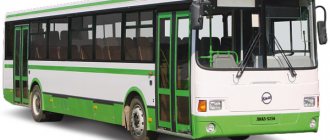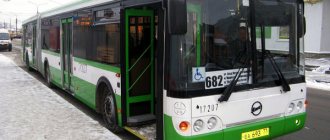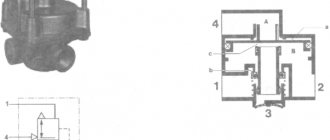Home Brands LiAZ LiAZ-5293
The LiAZ-5293 bus is a large, semi-low-floor bus for transporting passengers on city routes. The demand for low-floor and semi-low-floor buses is increasing every year. This is due to the convenience of loading and unloading passengers, which, in addition to comfort, also saves time. The time saved on boarding and disembarking passengers allows the driver to make another trip, which will bring additional profit. Therefore, large municipal organizations purchase such buses. And the production of this model is due to the fact that the company’s management follows global trends.
The bus itself combines acceptable environmental standards, pleasant appearance and optimal comfort for both the driver and passengers.
The platform of the new bus was LiAZ-5256, and the previous semi-low-floor model was called LiAZ-5292, but to say that LiAZ-5293 was its predecessor would be incorrect, since it was created only to reduce the cost of the model.
The model was shown in 2005, and the first copy rolled off the assembly line in 2006. To date, about 2,000 buses have been produced. Surprisingly, his presentation took place in Nizhny Novgorod, and not in Moscow, as is usually the case.
Dimensions
The model has a simple design with a large glass area. There are three doors for easy entry and exit. Since the bus is a large class bus, it has appropriate dimensions.
Dimensions:
- Length is 11400 mm;
- The bus turned out to be quite miniature in its width, which, without taking into account the side rear-view mirrors, is only 2.5 meters;
- Height – 3060 mm, but if you purchase a modification with a gas power plant, the overall height of the bus increases to 3322 mm;
- The wheelbase of LiAZ-5293 is 5840 mm;
- To turn, you will need a radius of at least 11500 mm;
- The curb weight is 10.5 tons, but the vehicle can be fully loaded up to 17.7 tons.
There are five modifications in total, two of which have already been discontinued due to non-compliance with Euro standards of the current period.
- 5293.00 – produced from 2006 to 2010.
- 5293.53 – from 2010 to 2012.
Currently, the following three modifications are available:
- 5293.54;
- 5293.60;
- 5293.70
Overview of the main characteristics of the bus
The LiAZ 5293 uses a dual-circuit drum-type braking system that acts on all wheels. The ABS system is also included as standard. The steering mechanism is equipped with a hydraulic booster, which makes it easy to control the vehicle. The body is all-metal, load-bearing, carriage-type. For boarding passengers there are 3 doors with automatic opening from the driver's cabin. In total, the cabin can accommodate up to 100 people, and the number of seats is 25. There is also one special seat for a passenger with limited mobility and his wheelchair.
Dimensions of the bus: length - 11.4 meters, width - 2.5 meters, height - 3.06 meters, minimum turning radius - 11.5 meters, wheelbase - 5.84 meters. The width of the passage when the doors are opened is 1.3 meters. The curb weight of the vehicle is 10.12 tons, and the gross weight is 17.1 tons. The bus with gas equipment has a height of 3.322 meters, and it is also 300 kilograms heavier. The fuel tank capacity is 238 liters. The gas modification has 8 cylinders of 97 liters each and 1 spare cylinder of 82 liters. The wheel formula of the bus is 4x2. Tires used are 275/70 R22.5″.
The salon has natural ventilation through opening side windows, as well as forced ventilation using ceiling fans. The heating system uses heat from engine cooling and an autonomous liquid heater. The heated liquid circulates throughout the cabin, ensuring uniform heating of the interior space. The driver's compartment is separated from the passenger compartment by a special partition, which creates good sound insulation. This allows the driver not to be distracted by extraneous sounds and fully concentrate on driving the bus. A loudspeaker is installed in the cabin, which allows you to make announcements to the cabin.
LiAZ 5293 has a high safety margin, so its maintenance and repair do not cause much trouble. The lifespan of the body is about 12 years, and all major systems can easily withstand a mileage of several hundred thousand kilometers. Getting the necessary spare parts for the LiAZ 5293 is also not difficult. You can always buy them from official dealers.
Today LiAZ 5293 costs about 5 million rubles.
Salon
The interior is very comfortable for the company's buses. All glass is well laminated, and the body has good heat and sound insulation. The basic equipment is equipped with a cabin heater (autonomous liquid heater), and an air conditioner can be ordered as an option. The driver of the LiAZ-5293 sits in a comfortable seat, which is separated from the passengers by a plastic partition with good sound insulation, which allows him not to be distracted from the road. The chairs themselves are made of plastic, have fabric upholstery and an anti-vandal system.
The dashboard and console look simple, without luxury, with a large set of control keys, and the 2-spoke steering wheel column is almost vertical.
In total, the cabin can accommodate 100-104 people, however, there are only 24-25 seats.
Asia
India
Bangalore
Bangalore is one of the first cities in India to introduce low-floor buses. At Bangalore Metropolitan Transport Corporation, BMTC operates many services using premium Volvo[2] 8400LE Low Floor buses. These buses are air-conditioned and offer features such as automatic transmission, kneeling capability and wheelchair ramps typical of modern city buses. They are also equipped with LED displays as well as ITS for stop notifications. The corporation also tried low-floor Mercedes-Benz buses as well as Ashok Leyland ULE coaches, but chose to stick with Volvo's offering.
To keep bus ticket prices low, BMTC operates most of its services using non-air-conditioned semi-low floor (SLF) buses, which have a floor height of 650 mm compared to the 400 mm floor height of true low floor buses. . These buses are being supplied by Ashok Leyland and Tata Motors, with future procurement planned from Eicher (VECV). This cheaper alternative to low-floor buses does not have knee- or wheelchair-accessible ramps, but they do have air suspension and use the same or better seats as Volvo buses. They also have a manual transmission rather than an automatic transmission.
New Delhi
Low Floor AC Buses in Delhi
With the introduction of Bus Rapid Transit (BRT) and the development of dedicated service corridors, bus services are set to improve.[3] The Delhi Transport Corporation (DTC) has started introducing air-conditioned buses and new low-floor buses (with a floor height of 400 mm (15.75 in) and even higher in one-third of the area compared to 230 mm (9.06 in) available internationally) on city streets to replace conventional buses.[4] A plan is currently underway to upgrade bus stops in the city and integrate GPS systems in DTC buses and bus stops to provide reliable information on bus arrivals. The Delhi government has decided to expedite the process and had earlier procured 6,600 low-floor buses for DTC. Commonwealth Games in 2010.
Calcutta
Further information: Transport in Kolkata
Kolkata has an extensive network of government buses. Recently, air-conditioned buses were introduced by WBSTC. These buses connect places like Kolkata Airport, Barasat (Capital of Northern Suburbs), New Town, Salt Lake, Howrah, Santragachi (a station on the Howrah-Kharagpur railway line), Kudgaht and Tollygunge. The road network in Kolkata is extensive. As part of Jawaharlal Nehru's National Urban Renewal Mission, air-conditioned buses were included as part of the comfort for passengers. The air-conditioned buses are operated by the West Bengal Land Transport Corporation (WBSTC) directly or through outsourcing. These buses are operated by Tata Marcopolo and Volvo Low Floor Buses. The V and VS series bus routes are operated by Volvo AC buses while the MW series is served by Tata Marcopolo buses operated by WBSTC. AC Marcopolo buses serve the MH series route operated by WBHIDCO and the MB series route operated by BHBL. The Kolkata State Transport Corporation (CSTC) also operates AC Volvo Bus and Ashok Leylan JanBus.
Jaipur (Jaipur)
- Non-AC: There are several non-AC buses in the city. There are 10 routes in total, 7 radial and 10 circular.
- AC: There are two AC routes namely AC-1 and AC-2. JCTSL operates buses from Ashok Leyland
Japan
Japanese low-floor Omnibus in Hamamatsu
In Japan, a low-floor bus is called a "stepless bus (ノンステップバス)". Mitsubishi Fuso Truck and Bus Corporation used to call a low-floor bus a "stepless bus (ノーステ)ップバス)".[5]At the Enshu Railway Company in the Hamamatsu area, the low-floor bus is called "omnibus (オムニバス)", Cho-Teisho
bus (超低床バス; very low-floor bus)" and "
Cho-Teisho
omnibus (超低床オムニバス; very low-floor omnibus)."
The Japanese government calls the low-floor bus " Cho-Teisho
stepless bus (超低床ノンステップバス; very low-floor stepless bus)."
The term "step-free bus" can also refer to a high-floor bus, where the floor is flat to align with high platforms in certain conditions. Bus Rapid Transit system. Thus, calling it a stepless high-floor bus.
Specifications
The model today is equipped, depending on the modification, with three 6-cylinder power units, two of which are diesel, and the third is gas. All engines meet at least the Euro-4 environmental standard.
- The LiAZ-5293.54 modification has in its arsenal a Cummins ISB6.7e4345B diesel engine, the volume of which is 6.7 liters. Power is 231 horsepower and torque is 925 Nm, which is available in such quantities already at 1400 rpm.
- Modification 5293.60 is also driven by a diesel power unit, but from YaMZ with the index 5362. The volume of this unit is 6.65 liters, and, like the previous one, it is equipped with a turbocharger. Maximum power is 245 hp and torque is 897 Nm.
- 5293.70 hides under the hood a Cummins CG8.3E4250 gas unit with a displacement of 8.23 liters. Maximum power is 255 hp, and the torque achieved at the same 1400 rpm is 1020 Nm.
This power is transmitted through ZF and Allison automatic transmissions to the rear axle, allowing the LiAZ-5293 bus to accelerate to 90 km/h. The suspension is dependent, pneumatic, with two elastic elements in the front and four in the rear.
The steering is complemented by a hydraulic booster, and the brakes are a dual-circuit system, ABS and a full drum structure.
Content
- 1 Configuration 1.1 Low-floor and low-access buses
- 1.2 Suspension and transmission
- 1.3 Other properties
- 3.1 India 3.1.1 Bangalore
- 4.1 United Kingdom
- 5.1 United States
- 6.1 Australia 6.1.1 Brisbane
Europe
United Kingdom
Arriva Southend Plaxton Pointer bodied Dennis Dart SLF Docherties Midland Coaches Optare Solo 880 at Bracknell Bus Station in June 2010 National Express Cayetano Levante healthy Scania K340EB 6x2 with wheelchair lift at a bus rally at the Metrocentre in May 2009 At
Dennis The Dart SLF (Super Low Floor) marked the mass introduction of single-deck low-floor buses in the United Kingdom in 1995, after many small demonstrations. Low-floor buses were quickly introduced on high-value routes, becoming a particular requirement for London bus contracts. The Optare Solo, introduced in 1997, marked another change by penetrating smaller areas traditionally served by minibuses. The final stage came with low-floor double-deckers in the Dennis Trident 2 and Volvo B7TL entering the mass market, although they were introduced after the Optare Spectra.
Due to the deregulated nature of the public transport system in the UK, the introduction of more expensive low-floor buses was usually accompanied by some kind of grant or quality partnership with the local authority, as the profitability of many routes was not high enough to justify conversion solely on increased revenue. However, it has been reported that the adoption of so-called Easy Access
buses actually have a positive impact on ridership and income levels.
Under the Transport Act 1985, the Disabled Persons' Transport Advisory Committee (DPTAC) (or commonly DiPTAC) was established to provide independent advice on accessibility issues.[6] In the same year, DPTAC developed the first specification for a low-floor bus. The Disability Discrimination Act 1995 provided for the completion of the Public Vehicle Accessibility Regulations 2000,[7] which stated that all new public vehicles with more than 22 seats must have a low floor from 31 December 2000, and vehicles smaller size - from January 1, 2005. The 2000 rules do not require retrofitting existing vehicles or forcing the sale of four-wheel drive vehicles. compatible with existing vehicles, allowing operators to use high-floor vehicles until the “end of their useful life.” In fact, as the prevalence of low floor buses coupled with grants/incentives is likely to decline significantly before all buses are deregistered by October 27, 2014. In times of economic disinvestment, it was not uncommon for service buses to remain in use for 15 to 20 years.
Although some coaches were produced with a small front end with a low floor at driver level, most buses in the UK have become accessible through the use of wheelchair lifts, with Cayetano Levante being one of the largest introductions since 2005.[8]
While another widely claimed benefit of low-floor buses is faster boarding of able-bodied passengers due to the lack of steps, research in the UK has shown the opposite effect. This is apparently due to the prevailing system of operation, in which passengers enter and exit through a single entrance door. It has been suggested that the previous high-step entry buses of the 1980s/90s, which had a center rail, promoted bi-directional flow of passengers entering and exiting simultaneously. The removal of the wheelchair/buggy access pole created a situation where the typically polite British bus passenger would wait until all passengers had disembarked before boarding, resulting in an increase in passenger numbers. duration of stay.[ quote needed
]
Recommendations
- Schaller, Bruce; Dana Lowell; Kenneth R. Stewart (May–June 1998). “MTA Transit Research in New York Shows What Customers Want from Low-Floor Buses.” Schaller Consulting. Retrieved April 29, 2009.
- Volvo Buses India.
- Agency (January 20, 2010). "Next BRT Corridor in East Delhi: Dixita." Indian Express
. Retrieved February 26, 2011. - Bhatnagar, Gaurav Vivek (25 September 2007). “The first new low-floor bus for DTC has arrived.” Hindu
. Retrieved February 26, 2011. - Japanese "ノーステップバス"
- UK Government Archived 7 August 2008 Wayback Machine
- Transport for you
- BBC
- King, Rolland D. (1994). Low-floor transit buses: a synthesis of transit practice (PDF) (Report). Transportation Research Board. ISBN 0-309-05321-8. Retrieved December 12, 2022.
- Melanithia, Michael; Henke, Cliff (25 August 2008). "High-level buses worth a second look." Metro Magazine
. Retrieved December 12, 2022.
Oceania
Australia
Brisbane
In Brisbane, all TransLink buses are low-floor design. A small number of higher-capacity articulated low-floor buses are used to service southern city highways.
Sydney
In Sydney, routes can be operated as high-floor and low-entry buses. Selected routes may be designated specifically for low entry buses, which are considered wheelchair accessible routes. A recently created low-entry bus network is the Metrobus system.










